There are a lot of great exercises in the fitness library.
However, there are also a bunch of bad exercises. Chances are, you’re probably doing some of them.
Here is a list of the 9 worst exercises you can do.

This post will discuss :
- The Top 9 Worst Exercises of All Time
- Why These Are Exercises To Avoid
- Alternative Options That You can do Instead
Many people will argue that there are no bad exercises, only bad execution.
They have a point: Any exercise done with bad form can be a bad exercise.
But the exercises that are done properly and still put you at an above-average risk of injury are the ones that need to be avoided.
Let go over them now.
1. Sit-Ups
Far too many people believe that countless sit-ups are the key to getting a six-pack.
While this exercise will indeed cause fatigue of the abdominal muscles, you might be doing them at the expense of your spinal health.
Sit-ups are not a functional movement of the human body.
Aside from getting up from bed in the morning, how often do you flex your spine from a lying position?
It’s even worse if you clasp your hands behind your neck and yank on the back of your head to help you perform the repetitions.
Even Harvard wrote an article on why sit-ups are bad for you.
The bulk of your abdominal training should come from functional exercises.
The ones that help us move better and obtain stronger positions in our normal activities of daily living.
There are far better ways of building core strength that does not involve constant flexion of your spine.
Start by getting yourself an ab wheel. Order one here if you need one.
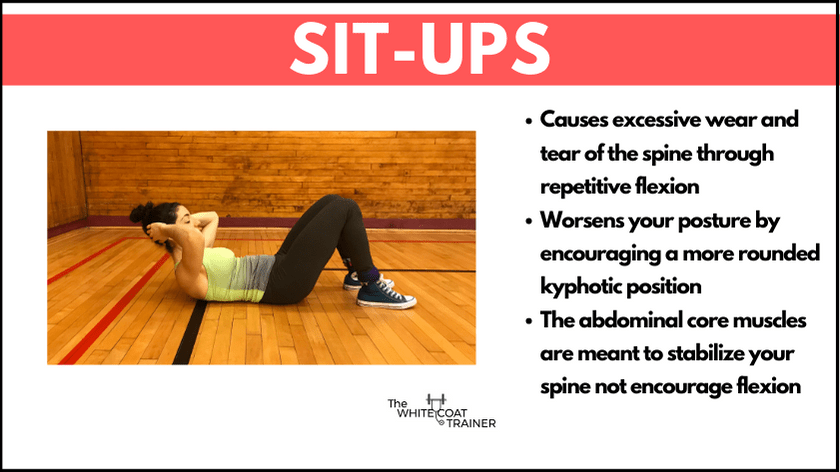
Cons: Why Are Sit-ups Bad For You?
- Causes excessive wear and tear of the spine through repetitive flexion
- Worsens your posture by encouraging a more rounded kyphotic position
- The abdominal core muscles are meant to stabilize your spine not encourage flexion
- Can lead to an increase in lumbar spinal injury, especially if you already have a history of lower back pain.
Alternatives to Sit-Ups:
- Planks (with a hollow body position) ,
- Leg Lifts / Leg Raises,
- Ab Wheel Rollouts (with a hollow body position)
2. Tricep Kick Backs
The tricep kickback is a worthless exercise in my opinion.
It is way too easy to do it with improper form, AND performing a full range of motion requires a good deal of flexibility.
Secondly, you are severely limited by the amount of weight you can use in this exercise. It’s just too awkward to use any significant resistance as your shoulders have to be in an extended and externally rotated position.
As a result, you are forced to train each arm individually as it is extremely difficult to perform both arms at the same time.
Having to do each arm individually (in this particular exercise) increases the length of your workout provides little to no benefit.
*There are numerous exercises where training each side individually is beneficial, but tricep kickbacks isn’t one of them*
There are plenty of better ways to train your triceps.
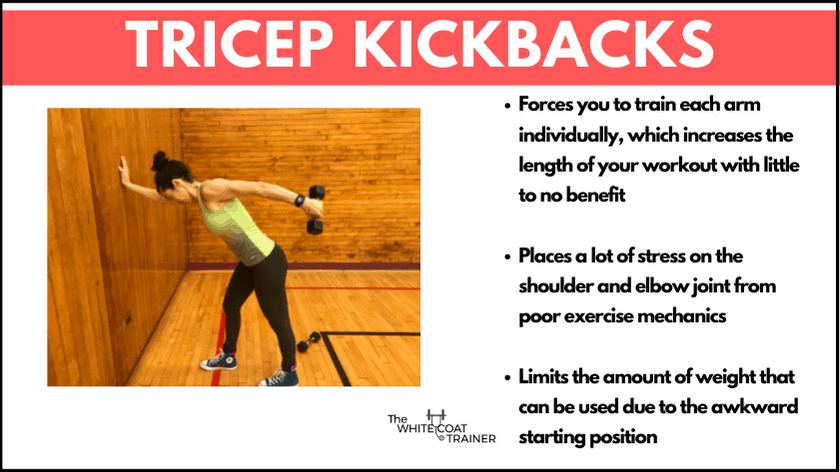
Cons: Why Are Tricep KickBacks Bad?
- Forces you to train each arm individually, which increases the length of your workout with little to no benefit
- Places a lot of stress on the shoulder and elbow joint from poor exercise mechanics
- Limits the amount of weight that can be used due to the awkward starting position
Tricep KickBack Alternatives:
3. Pseudo Pull-Ups
I believe that everyone should do pull-ups/chin-ups on a regular basis. (I personally have a pull-up tower so that I can do them at home regularly.)
This is the one I have from Amazon.
But unfortunately, the name “chin-up” has done this exercise a great disservice.
Somehow, many people have assumed that the point of the exercise is to get your chin above the bar.
They do whatever it takes to get their chin to clears the bar so that the rep could ‘count.’
Here is the truth.
At no point should your chin/neck ever be involved in this exercise.
To perform the pull-up correctly, you need to use your upper back and lat muscles. Check out our complete pull-up tutorial here.
When you reach the end range, your chin should naturally clear the bar.
If you cannot get your chin to clear the bar without moving your chin, then you are not doing pull-ups. You are doing pseudo-pullups.
This is doing absolutely nothing for you or your strength. Your neck should remain neutral and never change position throughout the lift.
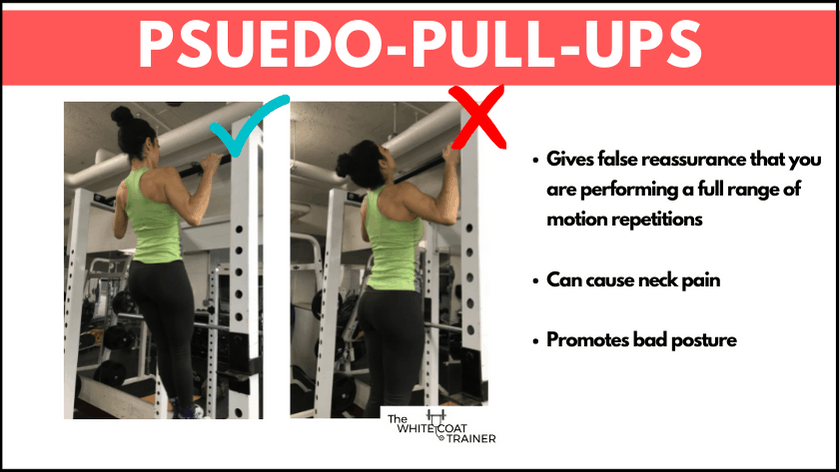
*Note the difference- in the range of motion. In the properly executed pull-up, the chin naturally clears the bar once the full range of motion has occurred
The bottom line?
Stop jerking your neck back so that your chin clears the bar while in actuality, you are performing half-repetitions.
There are many other pull-up variations you can benefit from that will allow you to perform a full range of motion.
Cons: Why Are Pseudo-Pull-ups Bad For You?
- Gives false reassurance that you are performing a full range of motion repetitions
- Can cause neck pain
Psuedo Pull-Up Alternatives:
4. Chair Dips
Dips are traditionally a great compound exercise for the upper body.
In essence, they are a much more difficult variation of a push-up.
However far too many people are trying to perform this advanced exercise without adequate preparation.
Even worse, a lot of workout programs recommend that beginners do a scaled variation of this exercise on a chair or a bench.
The chair makes it easier because your feet are flat on the floor taking away a lot of the weight that you need to lift.
However, the chair dip variation is an awful exercise because many people do not have adequate shoulder range of motion to perform this movement safely and effectively.
When looking from the side many people allow their shoulders to go into extreme internal rotation which is a very compromising position.
This forward shoulder roll leads to a lot of damage to the joint, and more money in your orthopedic surgeon’s pocket.
HOWEVER:
* If you want to do this exercise, just make sure to
- TURN YOUR HANDS OUT (and not forward) and
- pinch your shoulder blades together
to keep your shoulder joint in a safe position.*o keep your shoulder joint in a safe position.*
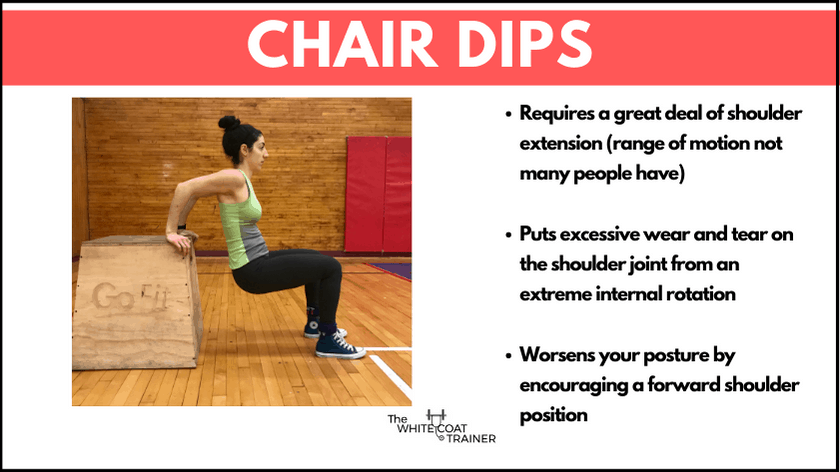
Cons: Why Are Chair Dips Bad For You
- Requires a great deal of shoulder extension (range of motion not many people have)
- Puts excessive wear and tear on the shoulder joint from an extreme internal rotation
- Worsens your posture by encouraging a forward shoulder position
Chair Dips Alternatives:
5. Upright Rows
The shoulder upright row is an exercise where you grab two dumbbells (or a barbell) and you lift the weight straight up towards your chin while keeping the weight really close to your body.
The problem with this exercise is that it puts your shoulder into an extreme level of internal rotation.
This puts your rotator cuff into a compromising position and increases the chances of causing shoulder impingement.
It’s just not worth it.
There are plenty of other exercises you can do to train your shoulders and upper back.
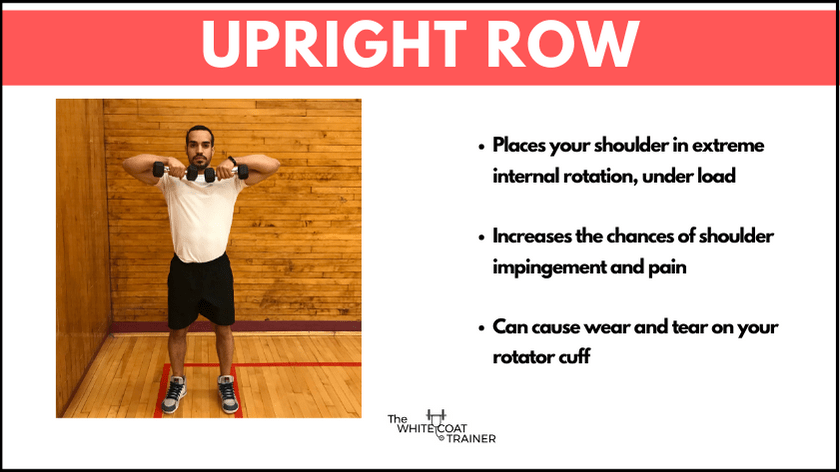
Why is The Upright Row Bad For You?
- Places your shoulder in extreme internal rotation, under load
- Increases the chances of shoulder impingement and pain
- Can cause wear and tear on your rotator cuff
Upright Row Alternative:
- Power Cleans
- DB Overhead Press
- Dumbbell Lateral Raise
6. Behind the Neck PullDown
The Behind the Neck Pulldown is performed on a cable Lat Pulldown machine.
Instead of pulling the weight down to their chest (how the exercise is meant to be done), you pull the weight down behind their neck.
People assume that they can get a better activation of the lat muscles this way since they are pulling in a more vertical plane.
The problem is, you have to crank your neck forward to do this exercise.
Secondly, you place your shoulders in a very unnatural, externally rotated position that is fixed to the bar.
This is also true of the Behind The Neck Overhead Presses. Both exercises have the same risk.
It’s not worth getting the additional deltoid or lat activation if you injure your neck or your shoulders.
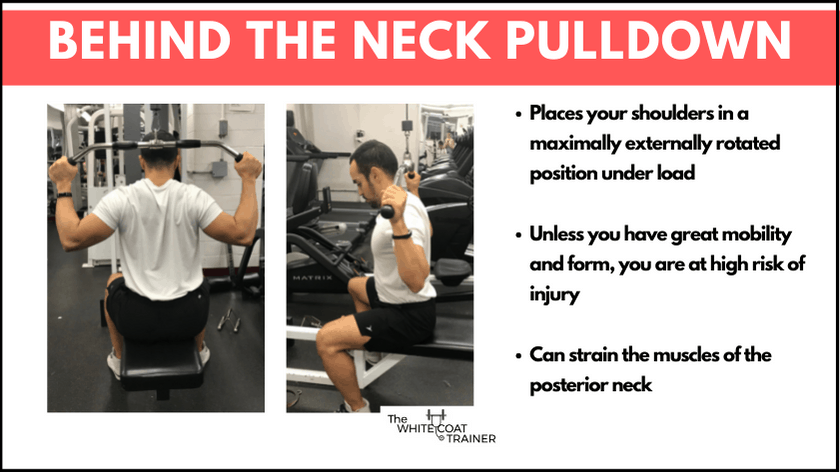
Why Is The Behind The Neck Pull-Down Bad For You?
- Places your shoulders in a maximally externally rotated position under load
- Unlesss you have great mobility and form, you are at high risk of injury
- Can strain the muscles of the posterior neck
Behind The Neck PullDown Alternatives:
7. Loaded Back “Hyper-extensions”
Does anything with the word hyper sound good to you?
What about a “hyper” extension of your low back?
Unfortunately, this exercise has been misnamed to the detriment of the fitness industry.
I’m sure you’ve seen this exercise many times before.
You get on a back raise machine, hold a weight on your chest and go to town bending at the spine all the way down…
… and then all the way back up until you can’t anymore.
Your low back should never extend beyond its natural capabilities. Ideally, it should never extend past a neutral spinal position.
Here’s a shocking statistic: According to the NIH, 80% of adults will develop low back pain at some point in their lives.
This is a proper back raise: Note that the spine should never hyper-extend beyond this point.
Keep your glutes engaged at the top of the movement.
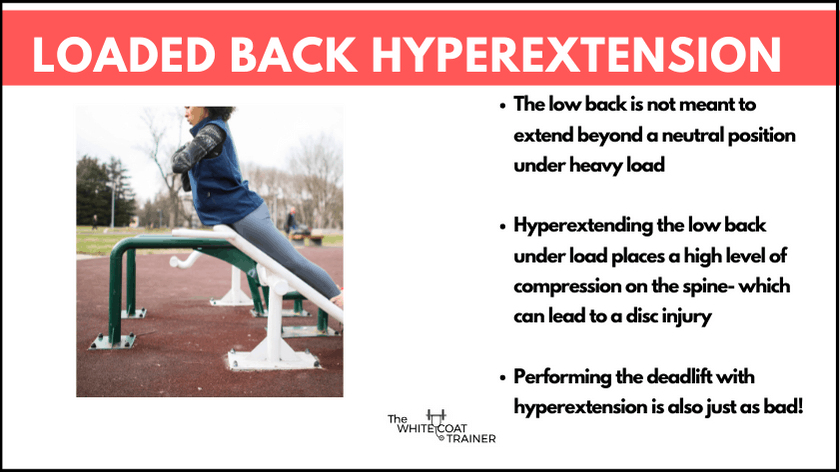
Why Are Loaded Back Hyperextensions Bad For You?
- The low back is not meant to extend beyond a neutral position under heavy load
- Hyperextending the low back under load places a high level of compression on the spine- which can lead to a disc injury
- Performing the deadlift with back hyperextension is also just as bad!
Back Hyperextension Alternatives:
8. Shrugs
Shrugs aren’t necessarily a bad exercise. The problem is, far too many people do it
- too early in their lifting career,
- use as heavy weight as they could possibly load, and
- use as much body english as humanly possible
This is made worse if you allow your neck to crank back and forth throughout the reps.
Like Mark Rippetoe says, you have no business performing this exercise if you cannot power clean 225 lbs.
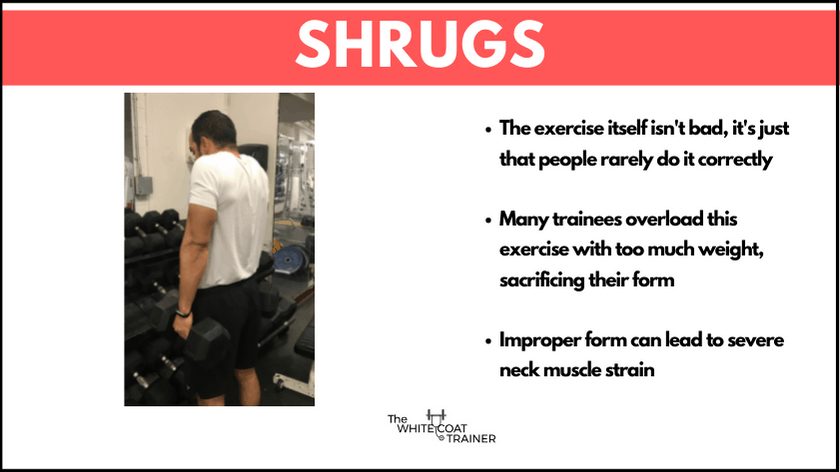
Why Are Shrugs Bad For You
- The exercise itself isn’t bad, it’s just that people rarely do it correctly
- Many trainees overload this exercise with too much weight, sacrificing their form
- Improper form can lead to severe neck muscle strain
Shrug Alternatives:
9. Any Exercise on the Smith Machine
The smith machine is quite honestly the worst piece of equipment any gym has.
It’s the machine that has a barbell that is fixed and can only move in an up-and-down fashion.
The producers of the machine promote it as being a safer alternative to free weights, which is just wrong.
Sadly, people perform all kinds of barbell exercises on the smith machine, including:
- squat,
- bench press,
- shoulder press, and
- barbell rows in this contraption.
The truth of the matter is, this machine can be more dangerous than free weights as the fixed barbell forces your body into strange positions that it can’t normally achieve.
This can potentially lead to back issues such as disc herniations.
The smith machine also removes the major benefits of free weights which is the need to stabilize yourself while supporting the weight.
There are much easier and safer ways to scale barbell exercises to your needs.
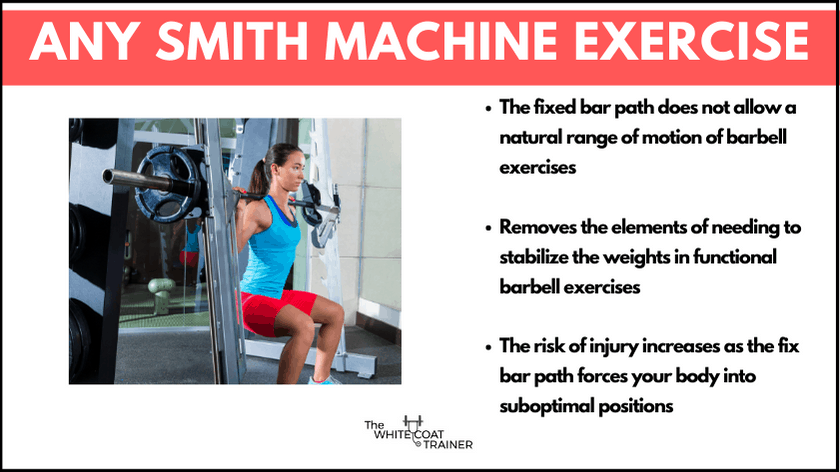
Why The Smith Machine is Bad For You
- The fixed bar path does not allow a natural range of motion of barbell exercises (especially the smith machine squat).
- Removes the elements of needing to stabilize the weights in functional barbell exercises
- Risk of injury increases as the fix bar path forces your body into suboptimal positions
Instead, Do:
- The free weight alternative to the exercise you are doing in the smith machine
10. The Most Dangerous Exercise To Avoid (*Bonus)
I want to end with the most dangerous exercise that everyone should avoid in all circumstances.
You MUST avoid any exercise that causes you pain or discomfort in any way.
With that said, you must be able to tell the difference between pain and difficulty.
Don’t avoid an exercise just because it’s difficult (aka training your legs).
But if anything feels funny, like:
- Pinching
- Pulling
- Electric-like pain
then you need to stop. There are always safer alternatives to any exercise.
Exercise should always feel smooth and natural.
The Best Exercises Everyone Should Do
Please, do yourself a favor and stop doing these exercises.
These exercises are potentially dangerous.
There are numerous exercises that you can perform which are safer, better, and more time-efficient than any of these.
We have written an entire post on The Complete List of Gym Exercises Everyone Should Do.
Other FAQ
Are There Exercises That Beginners Should Avoid?
A beginner should avoid any exercise that they cannot perform with proper form.
Although I advocate that you learn the large compound barbell lifts early, it is important that you learn how to do them properly before loading them up with heavy weight.
Other than that, a beginner doesn’t necessarily need to avoid any particular exercise (aside from the 10 I mentioned above).
Can Plank Exercises Hurt Your Back?
Yes. If done improperly, planks and other ab exercises can hurt your back.
When planking, it is important that you keep a neutral (or even rounded) back position throughout the entire exercise.
I describe this position in greater detail in my post on the best core exercises.
At no point in the exercise should you let your hips sag. This will cause your low back to arch and place it in a very compromising position.
What Are The Worst Exercises For The Shoulders?
Some of the worst potential exercises for your shoulders include
- Upright Rows
- Behind The Neck Pulldowns
- Behind The Neck Overhead Press
- Chair Dips (with your hands facing forward)
All of these exercises place your shoulder in extreme internally rotated positions.
This is a very compromising position where the risk is not justified.
What Are The Worst Exercises For The Rotator Cuff?
The same exercises that are bad for your shoulders are also bad for your rotator cuff muscles. See above.
What Are The Worst Exercises For The Knees?
Many people think that squatting is bad for your knees. If that were the case, how would we be able to poop?
Full squats are a very natural movement pattern that we must all be able to do.
Knee pain during squats is often due to improper form.
So with that said, what are the worst exercise for your knee joint?
Very Heavy Leg Extensions
I’ll let Jeff Cavaliere explain why this exercise isn’t good for you if you have bad knees.
What Are The Worst Exercises For The Back?
The worst exercises for the back are
- ones where you hyper-extend (aka arch) your low back under heavy load.
- ones where you repetitively flex your spine under heavy load
The three most popular exercises that place a lot of pressure on the low back include:
- Sit-ups
- Loaded Back Hyper-extensions (going past neutral)
- Poorly executed deadlifts (hyper-extending at the top)
The majority of your ab training should come from static core exercises.
What Are The Worst Exercises For The Neck?
The worst exercises for your neck are the ones that aren’t meant to train your neck at all.
These include
- Psuedo Pull-ups (where you are only focused on clearing your chin above the bar)
- Shrugs (where you let your head protrude forward at the top)
In general, you should try to keep your neck neutral in every single exercise that you perform.
A Strength Training Program That Uses Only The Best Exercises (And Avoids The Worst Exercises)
There are more exercises that we can add to this list, but these are the most common.
Why risk performing the worst exercises and sabotage your fitness?
That is why we created the WCT Strength Template.
It is a 15-week workout program that takes all of the guesswork out of your exercise routine.
You won’t have to worry about doing mediocre, or dangerous exercises, and you can focus on the stuff that matters.
So if you want to build muscle, and gain strength in as little as 35 minutes a day, check out our template here.
Final Thoughts On The Worst Gym Exercises
To be completely honest, any exercise done with very poor form can be a bad exercise.
But the exercises that are done properly and still put you at risk are the ones that need to be avoided.
If anything feels funny, don’t do it. Stick with the best exercises, play it smart, and make a better choice.
Related Posts On Other Great Exercises:
- A Complete List Of The Best Compound Exercises
- The Best Bodyweight Exercises To Workout At Home
- How To Perform All Of The Best Exercises With Good Form
Now we turn it over to you:
Do you perform any of these detrimental exercises?
Do you have any other exercises to add to this list?
Comment below and let us know.
Share this list with them so that they can stop wasting their time.

Alex Robles, MD, CPT / Brittany Robles, MD, MPH, CPT
Alex & Brittany Robles are physicians, NASM CPTs, health & fitness experts, and founders of The White Coat Trainer: a site dedicated to improving the health and fitness of busy professionals. Their advice has been featured on KevinMD, The Doctor Weighs In, My Fitness Pal, Reader’s Digest, Livestrong, and The Active Times. Learn more about them here.

You should rename this article to “exercises people often do with bad form” because almost all of these have the potential to be good exercises if done properly (which you actually mentioned on several). The main two I would actually agree with are chair dips and behind the neck pull downs simply because standard dips and pulldowns are far superior. Ones ability to perform the exercise successfully is all it comes down to. There are too many different levels of form that are determined by so many different things such as strength to weight (used) ratio, mobility, practice, and even mind muscle connection.
Thanks for the comment. You make great points. Are there any other exercise you would add to this list?
I mostly agree with one addition. behind the neck pull-ups are bad, but if you do behind the neck cable lat pulls by keeping the elbows slightly in front of the shoulders, you will not injure the shoulder and it is a great exercise to increase pull-ups.
Romanian deadlifts, legpresses (vs squats), handstand push-ups…
Hi All,
People who still think sit-ups do you well, ask yourself the question:
Don’t you feel like a strain in or your lower back whilst doing them ? For example, try doing Russian twist sit-ups, I’ll guarantee you’ll feel it most at the level of your back whilst doing them.
This proves that they really don’t do your spine any good.
Just my opinion and experience,
No hatin’ please,
These exercises are not all bad for you. It is the bad techniques that people are using to perform the exercises. For example, Sit-ups- place the hands on opposite shoulders. This will levitate neck strain. Us your lower abs and hip flexors the same as you would if you are holding a medicine ball for sit-ups, you keep the spine in a natural position. If you want to engage the upper abs then reach with the elbows to the knees at the top of the movement.
I would also add front lateral dumbbell raises. If you do any kind of pressing at all, your anterior deltoids will definitely be worked. Most people should concentrate on doing side lateral and bent-over lateral raises to give the entire deltoid a uniform look, instead of having a bulging front deltoid and rear deltoids that are flat as a sheet of paper.
Steve, just a tip…there is no such thing as a “front lateral” raise. If it is in front, it is not lateral. If it is lateral, it is not front. You are probably talking about front raises I would guess? I would agree that your anterior head gets plenty of work when you press, however, front raises with your hands in a neutral position (on other words, palms facing each other) do work your anterior head. Up to the individual to decide how much worth their anterior delts needs.
Ive always heard that the seated leg raise is a terrible machine as well. Bad for the knees. Is that true? I am guilty of using the smith machine. Often times because I do not have a spotter.
There is evidence that the popular seated knee extension exercise (open chain) exerts tremendous compressive forces on the patella (knee cap). This, it is believed, paves the way for accumulative injuries which present as wear and tear of patella cartilage. If thigh development and strength are your goals, then Closed Chain exercises are best.
Thanks bro for such informative info of a bad side of certain exercise
Some of this info. is OK. But many of the alternatives are not much better. Planks, leg raises and ab wheel rollouts as alternatives to abs? The main function of your abs (rectus abdominis if that’s what you are referring to specifically) are to bring your chest to your pelvis/pelvis to chest. Planks are just plain silly. A simple static contraction. You could just sit or stand where you are and contract your abs to do the same thing. Leg raises? Your abs don’t even connect to your legs. Again, just a static contraction to stabilize your body.
Thanks for your comment. You’re right, the abs do work at flexing the trunk, but one of their biggest function is to resist motion as well. That is where exercises like planks and ab wheel rollouts come into play. In fact, this is how your core muscles are normally trained in real life situations, and how many of the major compound exercises train the core muscles as well. You don’t fall over when carrying a barbell on your back because your core is stabilizing your spine to resist motion. The same goes for the deadlift. You don’t want your trunk to flex under heavy load.
Thank you . really helpful, perfect and perfect